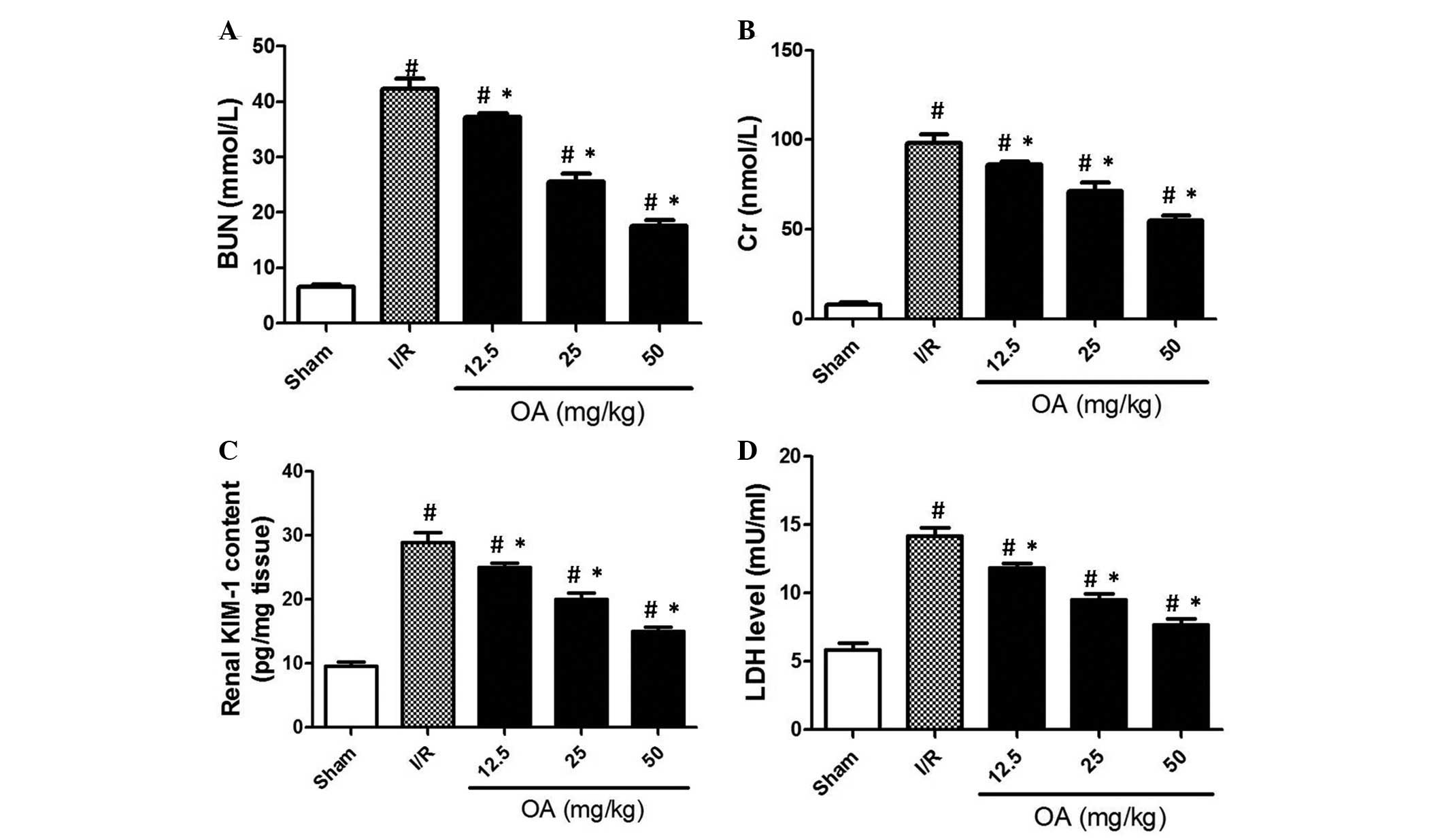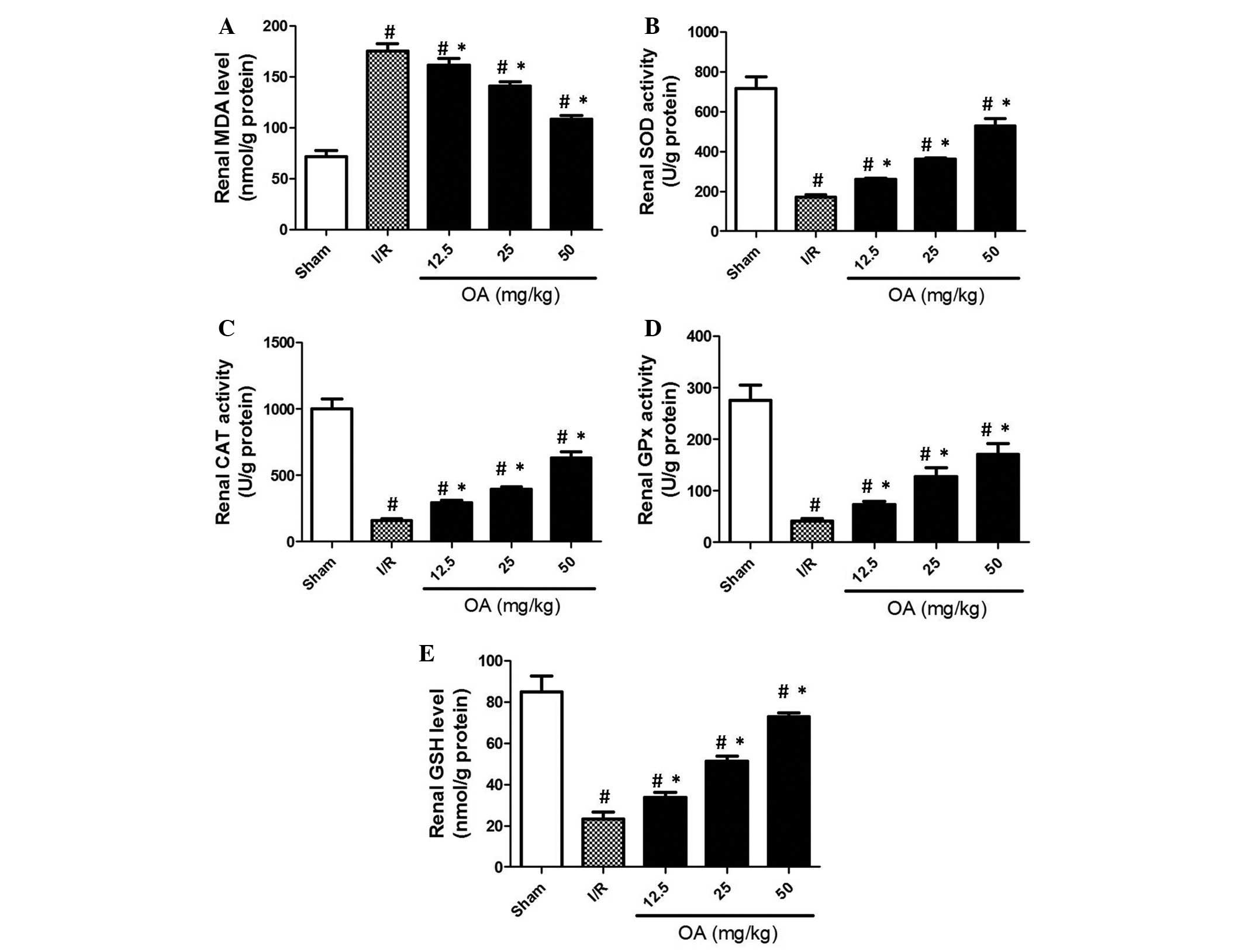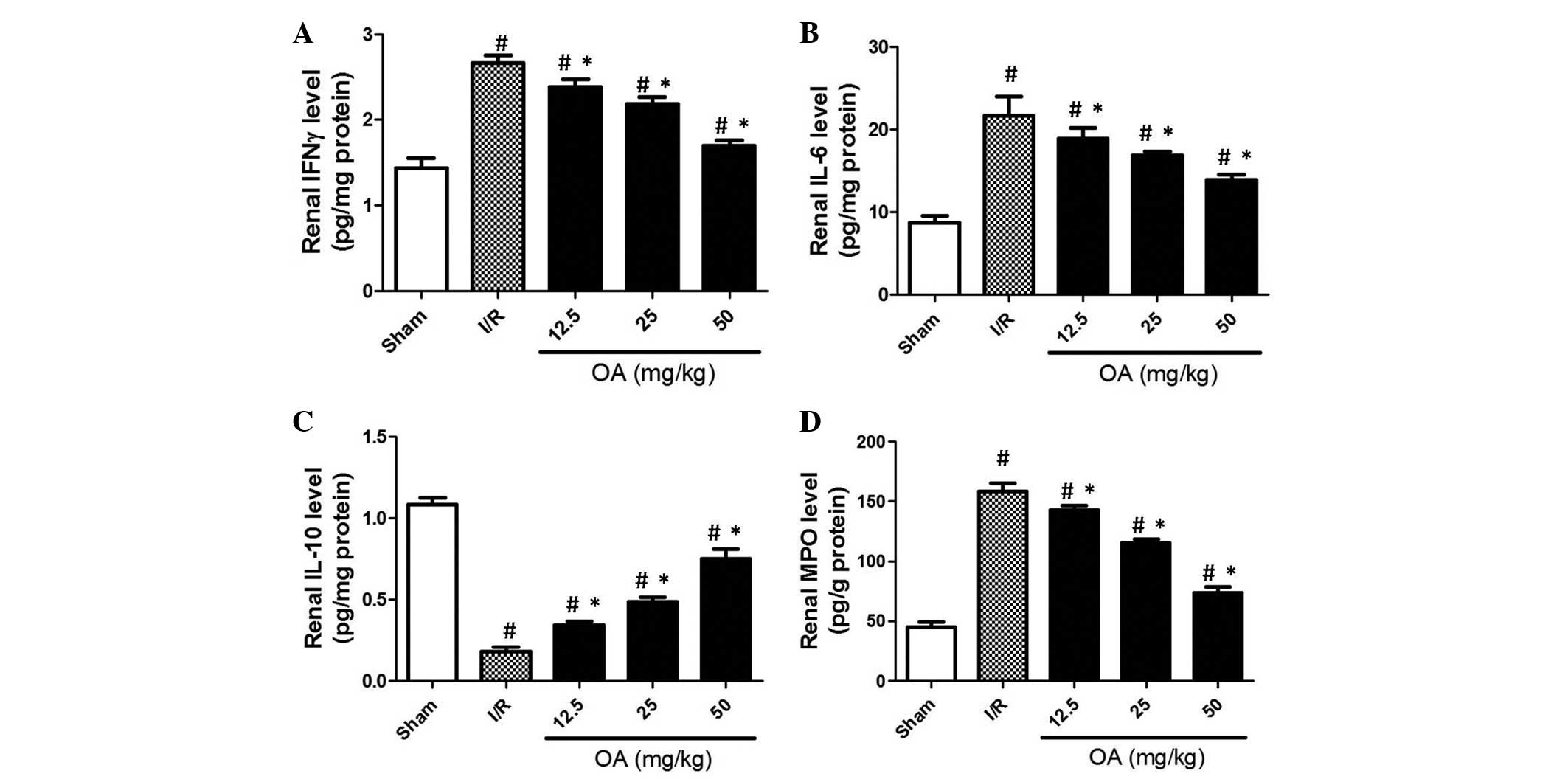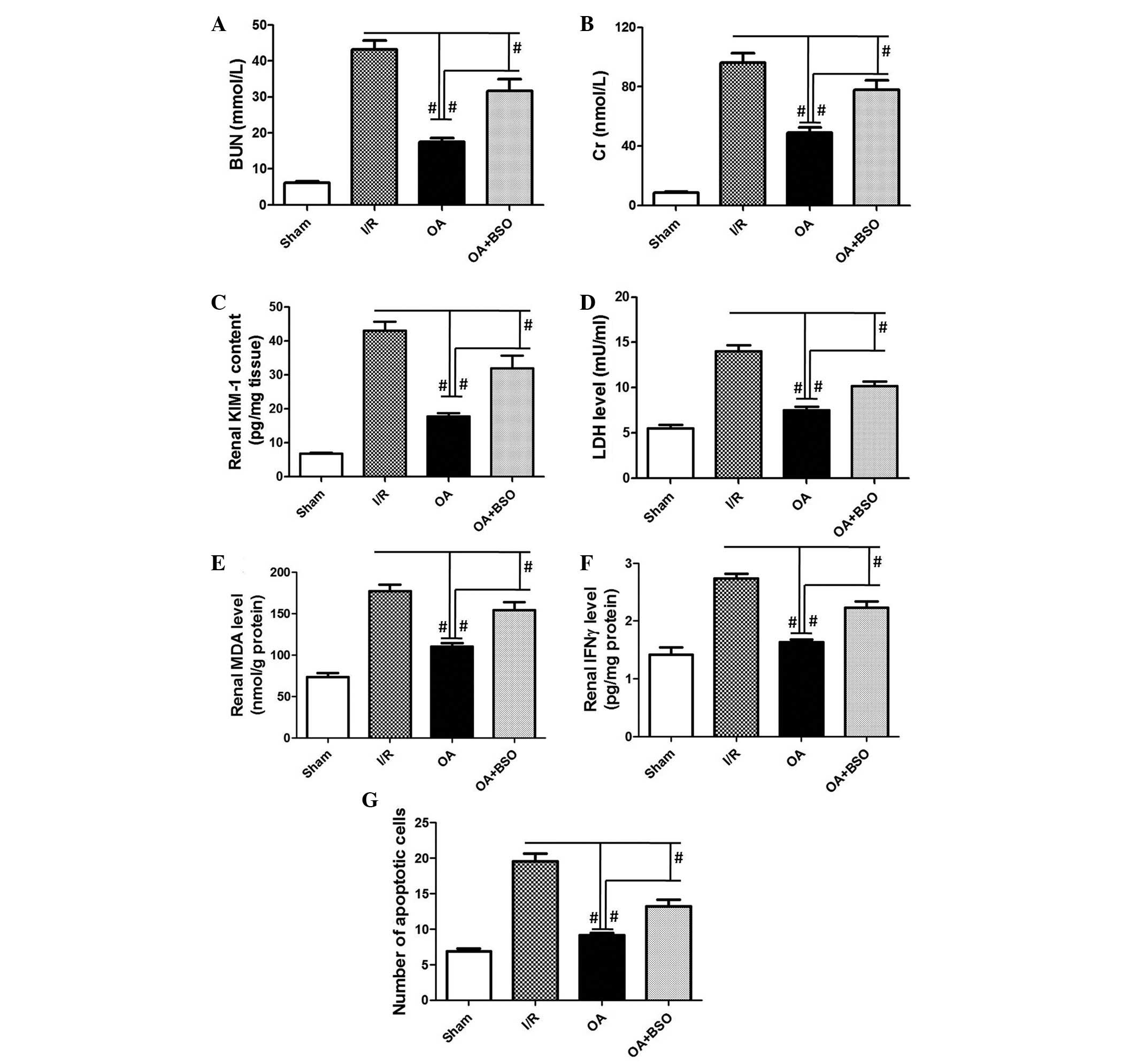|
1
|
Gueler F, Shushakova N, Mengel M, Hueper
K, Chen R, Liu X, Park JK, Haller H, Wensvoort G and Rong S: A
novel therapy to attenuate acute kidney injury and ischemic
allograft damage after allogenic kidney transplantation in mice.
PLoS One. 10:e01157092015. View Article : Google Scholar : PubMed/NCBI
|
|
2
|
Agrawal M and Swartz R: Acute renal
failure. Am Fam Physician. 61:2077–2088. 2000.PubMed/NCBI
|
|
3
|
Tuttle KR: Ischemic nephropathy. Curr Opin
Nephrol Hypertens. 10:167–173. 2001. View Article : Google Scholar : PubMed/NCBI
|
|
4
|
Simone S, Rascio F, Castellano G, Divella
C, Chieti A, Ditonno P, Battaglia M, Crovace A, Staffieri F,
Oortwijn B, et al: Complement-dependent NADPH oxidase enzyme
activation in renal ischemia/reperfusion injury. Free Radic Biol
Med. 74:263–273. 2014. View Article : Google Scholar : PubMed/NCBI
|
|
5
|
Niu J, Wu J, Li X and Zhang F: Association
between endothelin-1/endothelin receptor A and inflammation in
mouse kidneys following acute ischemia/reperfusion. Mol Med Rep.
11:3981–3987. 2015.PubMed/NCBI
|
|
6
|
Wang L, Liu X, Chen H, Chen Z, Weng X, Qiu
T and Liu L: Effect of picroside II on apoptosis induced by renal
ischemia/reperfusion injury in rats. Exp Ther Med. 9:817–822.
2015.PubMed/NCBI
|
|
7
|
Dong B, Zhou H, Han C, Yao J, Xu L, Zhang
M, Fu Y and Xia Q: Ischemia/reperfusion-induced CHOP expression
promotes apoptosis and impairs renal function recovery: The role of
acidosis and GPR4. PLoS One. 9:e1109442014. View Article : Google Scholar : PubMed/NCBI
|
|
8
|
Cruthirds DL, Novak L, Akhi KM, Sanders
PW, Thompson JA and MacMillan-Crow LA: Mitochondrial targets of
oxidative stress during renal ischemia/reperfusion. Arch Biochem
Biophys. 412:27–33. 2003. View Article : Google Scholar : PubMed/NCBI
|
|
9
|
Yang B, Jain S, Pawluczyk IZ, Imtiaz S,
Bowley L, Ashra SY and Nicholson ML: Inflammation and caspase
activation in long-term renal ischemia/reperfusion injury and
immunosuppression in rats. Kidney Int. 68:2050–2067. 2005.
View Article : Google Scholar : PubMed/NCBI
|
|
10
|
Wu HH, Hsiao TY, Chien CT and Lai MK:
Ischemic conditioning by short periods of reperfusion attenuates
renal ischemia/reperfusion induced apoptosis and autophagy in the
rat. J Biomed Sci. 16:192009. View Article : Google Scholar : PubMed/NCBI
|
|
11
|
El Morsy EM, Ahmed MA and Ahmed AA:
Attenuation of renal ischemia/reperfusion injury by açaí extract
preconditioning in a rat model. Life Sci. 123:35–42. 2015.
View Article : Google Scholar
|
|
12
|
Ilhan H, Eroglu M, Inal V, Eyi YE, Arziman
I, Yildirim AO, Tansel A, Uzun G and Yamanel L: Hyperbaric oxygen
therapy alleviates oxidative stress and tissue injury in renal
ischemia/reperfusion injury in rats. Ren Fail. 34:1305–1308. 2012.
View Article : Google Scholar : PubMed/NCBI
|
|
13
|
Chen H, Xing B, Liu X, Zhan B, Zhou J, Zhu
H and Chen Z: Ozone oxidative preconditioning inhibits inflammation
and apoptosis in a rat model of renal ischemia/reperfusion injury.
Eur J Pharmacol. 581:306–314. 2008. View Article : Google Scholar
|
|
14
|
Pérez-Camino MC and Cert A: Quantitative
determination of hydroxy pentacyclic triterpene acids in vegetable
oils. J Agric Food Chem. 47:1558–1562. 1999. View Article : Google Scholar : PubMed/NCBI
|
|
15
|
Wang X, Ye XL, Liu R, Chen HL, Bai H,
Liang X, Zhang XD, Wang Z, Li WL and Hai CX: Antioxidant activities
of oleanolic acid in vitro: Possible role of Nrf2 and MAP kinases.
Chem Biol Interact. 184:328–337. 2010. View Article : Google Scholar : PubMed/NCBI
|
|
16
|
Liu J, Wang X, Liu R, Liu Y, Zhang T, Fu H
and Hai C: Oleanolic acid co-administration alleviates
ethanol-induced hepatic injury via Nrf-2 and ethanol-metabolizing
modulating in rats. Chem Biol Interact. 221:88–98. 2014. View Article : Google Scholar : PubMed/NCBI
|
|
17
|
Nkeh-Chungag BN, Oyedeji OO, Oyedeji AO
and Ndebia EJ: Anti-inflammatory and membrane-stabilizing
properties of two semisynthetic derivatives of oleanolic acid.
Inflammation. 38:61–69. 2015. View Article : Google Scholar
|
|
18
|
Bischoff A, Bucher M, Gekle M and Sauvant
C: Differential effect of COX1 and COX2 inhibitors on renal
outcomes following ischemic acute kidney injury. Am J Nephrol.
40:1–11. 2014. View Article : Google Scholar : PubMed/NCBI
|
|
19
|
Wills ED: Mechanisms of lipid peroxide
formation in animal tissues. Biochem J. 99:667–676. 1966.
View Article : Google Scholar : PubMed/NCBI
|
|
20
|
Wang X, Hai CX, Liang X, Yu SX, Zhang W
and Li YL: The protective effects of Acanthopanax senticosus Harms
aqueous extracts against oxidative stress: Role of Nrf2 and
antioxidant enzymes. J Ethnopharmacol. 127:424–432. 2010.
View Article : Google Scholar
|
|
21
|
Grimholt RM, Urdal P, Klingenberg O and
Piehler AP: Rapid and reliable detection of α-globin copy number
variations by quantitative real-time PCR. BMC Hematol. 14:42014.
View Article : Google Scholar
|
|
22
|
Han WK, Bailly V, Abichandani R, Thadhani
R and Bonventre JV: Kidney Injury Molecule-1 (KIM-1): A novel
biomarker for human renal proximal tubule injury. Kidney Int.
62:237–244. 2002. View Article : Google Scholar : PubMed/NCBI
|
|
23
|
Vázquez-Frias R, Gutiérrez-Reyes G,
Urbán-Reyes M, Velázquez-Guadarrama N, Fortoul-van der Goes TI,
Reyes-López A and Consuelo-Sánchez A: Proinflammatory and
anti-inflammatory cytokine profile in pediatric patients with
irritable bowel syndrome. Rev Gastroenterol Mex. 80:6–12.
2015.PubMed/NCBI
|
|
24
|
Loria V, Dato I, Graziani F and Biasucci
LM: Myeloperoxidase: A new biomarker of inflammation in ischemic
heart disease and acute coronary syndromes. Mediators Inflamm.
2008:1356252008. View Article : Google Scholar : PubMed/NCBI
|
|
25
|
Wang X, Bai H, Zhang X, Liu J, Cao P, Liao
N, Zhang W, Wang Z and Hai C: Inhibitory effect of oleanolic acid
on hepatocellular carcinoma via ERK-p53-mediated cell cycle arrest
and mitochondrial-dependent apoptosis. Carcinogenesis.
34:1323–1330. 2013. View Article : Google Scholar : PubMed/NCBI
|
|
26
|
Kwak MK, Wakabayashi N, Itoh K, Motohashi
H, Yamamoto M and Kensler TW: Modulation of gene expression by
cancer chemopreventive dithiolethiones through the Keap1-Nrf2
pathway. Identification of novel gene clusters for cell survival. J
Biol Chem. 278:8135–8145. 2003. View Article : Google Scholar
|
|
27
|
Lu YF, Liu J, Wu KC, Qu Q, Fan F and
Klaassen CD: Overexpression of Nrf2 protects against
microcystin-induced hepatotoxicity in mice. PLoS One. 9:e930132014.
View Article : Google Scholar : PubMed/NCBI
|
|
28
|
Arrick BA and Nathan CF: Glutathione
metabolism as a determinant of therapeutic efficacy: A review.
Cancer Res. 44:4224–4232. 1984.PubMed/NCBI
|





















